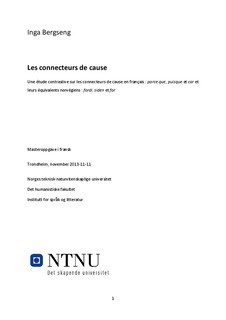| dc.description.abstract | This master’s thesis is a contrastive analysis on French and Norwegian causal connectives. I have compared the French connectives: parce que, puisque and car with the Norwegian equivalents, fordi, siden and for. As methods I used a corpus study and acceptability and judgment studies to find out whether the theories on the French causal connectives are compatible with the corresponding Norwegian connectives. The main theories used in this thesis are Sandrine Zufferey’s hypothesis that all use of the connective puisque contains a certain echo and Eve Sweetser’s theory concerning the significance domains.
This thesis concludes that the equivalent causal connectives have many similar features, despite the fact that they originate from two different language families. Zufferey’s theory of puisque being used in presence of some kind of echo source, seems to tally with the Norwegian equivalent siden, at least when this source is explicitly pronounced or when the utterance is ironic. The causal connectives for and siden are, like the French corresponding connectives (car and puisque), principally used in the pragmatic domains, while fordi is essentially used in the semantic domain, and in all domains in oral Norwegian, like the French parce que.
Nevertheless, recent studies find that car has developed from being a subjective connective to becoming one that is often used interchangeably with parce que. Parce que on the other hand, used to be an objective connective, but is today used in all domains. While the distinction between parce que and car seems to be a little fuzzy in French speaking countries, the difference between fordi and for seems to be distinct. This phenomenon might be due to the fact that car is nearly absent in oral French, and the reinforcement of the distinction between for and the two other Norwegian causal connectives, caused by the phenomenon of V2 and V3 in Norwegian language. | nb_NO |
